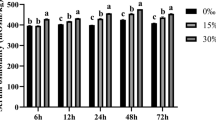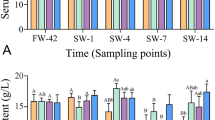Abstract
During salinity stress, osmoregulatory processes in euryhaline fish need to modify for their survival, and glucose is the preferred mode of extra energy during such conditions. These organisms must have a proper mechanism to maintain glucose homeostasis during such modified osmoregulatory process across different body fluids. Hence, we studied high salinity effect on regulation of glucose homeostasis in Mozambique tilapia. The fish were induced to 15‰ salinity for 21 days. Glucose, glycogen, ion concentrations, Na+-K+-ATPase, pyruvate kinase, γ-amylase activities and GLUT mRNA expressions were investigated in liver, intestine, gill and white muscle tissues. At the end of experiment, Na+ ion concentrations, glucose content and activity of Na+-K+-ATPase especially in the gill and intestine were increased, while decrease in liver and gill glycogen content was seen. Lower concentration of glycogen decrease was observed in the intestine and white muscle of the treated group. High pyruvate kinase activity was noticed in liver and gill tissues that correlates with high Na+-K+-ATPase activity. Elevated γ-amylase activity was observed in the liver and intestine suggesting breakdown of glycogen; however, gill and white muscle did not show any increased activity. Increase in GLUT1 and GLUT4 mRNA expressions was observed especially in the gill and intestine, while increase in GLUT2 mRNA expressions was observed in the liver. Upregulations of GLUTs suggest higher influx of glucose into the cell for catabolism to provide energy and further to drive the enhanced osmoregulatory process. These findings suggest glucose homeostasis being regulated in Mozambique tilapia during salinity acclimation.



Similar content being viewed by others
Data availability
Data generated during the current study are available from the corresponding author on reasonable request.
Code availability
Not applicable.
References
Abou Anni IS, Bianchini A, Barcarolli IF, Junior ASV, Robaldo RB, Tesser MB, Sampaio LA (2016) Salinity influence on growth, osmoregulation and energy turnover in juvenile pompano Trachinotus marginatus Cuvier 1832. Aquaculture 455:63–72. https://doi.org/10.1016/j.aquaculture.2016.01.010
Arjona FJ, Vargas-Chacoff L, Ruiz-Jarabo I, del Río MPM, Mancera JM (2007) Osmoregulatory response of Senegalese sole (Solea senegalensis) to changes in environmental salinity. Comp Biochem Physiol A 148:413–421. https://doi.org/10.1016/j.cbpa.2007.05.026
Balmaceda-Aguilera C, Martos-Sitcha JA, Mancera JM, Martínez-Rodríguez G (2012) Cloning and expression pattern of facilitative glucose transporter 1 (GLUT1) in gilthead sea bream Sparus aurata in response to salinity acclimation. Comp Biochem Physiol A 163:38–46. https://doi.org/10.1016/j.cbpa.2012.04.026
Bergmeyer HU, Gawehn K, Grassl M (1974a) Reagents for enzymatic analysis. In: Bergmeyer HU (ed) Methods of enzymatic analysis, Academic Press, vol I. Inc, New York, pp 154–155
Bergmeyer HU, Gawehn K, Grassl M (1974b) Reagents for enzymatic analysis. In: Bergmeyer HU (ed) Methods of enzymatic analysis, Academic Press, vol I. Inc, New York, pp 303–304
Bhoite S, Roy R (2013) Role of membrane lipid in osmoregulatory processes during salinity adaptation: a study with chloride cell of mud crab, Scylla serrata. Mar Freshw Behav Physiol 46:287–300. https://doi.org/10.1080/10236244.2013.832525
Caipang CMA, Brinchmann MF, Berg I, Iversen M, Eliassen R, Kiron V (2008) Changes in selected stress and immune-related genes in Atlantic cod, Gadus morhua, following overcrowding. Aquac Res 39:1533–1540. https://doi.org/10.1111/j.1365-2109.2008.02026.x
Carroll NV, Longley RW, Roe JH (1956) The determination of glycogen in liver and muscle by use of anthrone reagent. J Boil Chem 220:583–593
Chandrasekar S, Nich T, Tripathi G, Sahu NP, Pal AK, Dasgupta S (2014) Acclimation of brackish water pearl spot (Etroplus suratensis) to various salinities: relative changes in abundance of branchial Na+/K+-ATPase and Na+/K+/2Cl− co-transporter in relation to osmoregulatory parameters. Fish Physiol Biochem 40:983–996. https://doi.org/10.1007/s10695-013-9899-y
Chang JCH, Wu SM, Tseng YC, Lee YC, Baba O, Hwang PP (2007) Regulation of glycogen metabolism in gills and liver of the euryhaline tilapia (Oreochromis mossambicus) during acclimation to seawater. J Exp Biol 210:3494–3504. https://doi.org/10.1242/jeb.007146
Chen YJ, Zhang TY, Chen HY, Lin SM, Luo L, Wang DS (2017) An evaluation of hepatic glucose metabolism at the transcription level for the omnivorous GIFT tilapia, Oreochromis niloticus during postprandial nutritional status transition from anabolism to catabolism. Aquaculture 473:375–382. https://doi.org/10.1016/j.aquaculture.2017.03.009
Das M, Das S (2019) Docosahexaenoic acid (DHA) induced morphological differentiation of astrocytes is associated with transcriptional up regulation and endocytosis of β2-AR. Mol Neurobiol 56(4):2685–2702. https://doi.org/10.1007/s12035-018-1260-0
Fan H, Zhou Y, Wen H, Zhang X, Zhang K, Qi X, Li Y (2019) Genome-wide identification and characterization of glucose transporter (glut) genes in spotted sea bass (Lateolabrax maculatus) and their regulated hepatic expression during short-term starvation. Comp Biochem Physiol D 30:217–229. https://doi.org/10.1016/j.cbd.2019.03.007
Fiess JC, Kunkel-Patterson A, Mathias L, Riley LG, Yancey PH, Hirano T, Grau EG (2007) Effects of environmental salinity and temperature on osmoregulatory ability, organic osmolytes, and plasma hormone profiles in the Mozambique tilapia (Oreochromis mossambicus). Comp Biochem Physiol A 146:252–264. https://doi.org/10.1016/j.cbpa.2006.10.027
Guo T, Yang Y, Meng F, Wang S, Xia S, Qian Y, Wang R (2020) Effects of low salinity on gill and liver glycogen metabolism of great blue-spotted mudskippers (Boleophthalmus pectinirostris). Comp Biochem Physiol C 230:108–709. https://doi.org/10.1016/j.cbpc.2020.108709
Herrera M, Aragão C, Hachero I, Ruiz-Jarabo I, Vargas-Chacoff L, Mancera JM, Conceição LE (2012) Physiological short-term response to sudden salinity change in the Senegalese sole (Solea senegalensis). Fish Physiol Biochem 38:1741–1751. https://doi.org/10.1007/s10695-012-9671-8
Jarvis PL, Ballantyne JS (2003) Metabolic responses to salinity acclimation in juvenile shortnose sturgeon Acipenser brevirostrum. Aquaculture 219:891–909. https://doi.org/10.1016/S0044-8486(03)00063-2
Kammerer BD, Cech JJ Jr, Kültz D (2010) Rapid changes in plasma cortisol, osmolality, and respiration in response to salinity stress in tilapia (Oreochromis mossambicus). Comp Biochem Physiol A 157:260–265. https://doi.org/10.1016/j.cbpa.2010.07.009
Krogdahl Å, Hemre GI, Mommsen TP (2005) Carbohydrates in fish nutrition: digestion and absorption in postlarval stages. Aquac Nutr 11:103–122. https://doi.org/10.1111/j.1365-2095.2004.00327.x
Liang F, Li L, Zhang G, Yin S, Wang X, Li P, Wang X (2017) Na+/K+-ATPase response to salinity change and its correlation with FXYD11 expression in Anguilla marmorata. J Comp Physiol B 187:973–984. https://doi.org/10.1007/s00360-017-1059-8
Lin YS, Tsai SC, Lin HC, Hsiao CD, Wu SM (2011) Changes of glycogen metabolism in the gills and hepatic tissue of tilapia (Oreochromis mossambicus) during short-term Cd exposure. Comp Biochem Physiol C 154:296–304. https://doi.org/10.1016/j.cbpc.2011.06.014
Lin CH, Kuan WC, Liao BK, Deng AN, Tseng DY, Hwang PP (2016) Environmental and cortisol-mediated control of Ca 2+ uptake in tilapia (Oreochromis mossambicus). J Comp Physiol B 186:323–332. https://doi.org/10.1007/s00360-016-0963-7
Lisboa V, Barcarolli IF, Sampaio LA, Bianchini A (2015) Effect of salinity on survival, growth and biochemical parameters in juvenile Lebranch mullet Mugil liza (Perciformes: Mugilidae). Neotrop Ichthyol 13:447–452. https://doi.org/10.1590/1982-0224-20140122
Lowry OH, Rosebrough NJ, Farr AL, Randall RJ (1951) Protein measurement with the Folin phenol reagent. J Biol Chem 193:265–275
Mehrani H, Storey KB (1993) Characterization of α-glucosidases from rainbow trout liver. Arch Biochem Biophys 306:188–194. https://doi.org/10.1006/abbi.1993.1499
Murat JC (1976) Studies on glycogenolysis in carp liver: evidence for an amylase pathway for glycogen breakdown. Comp Biochem Physiol B 55:461–465. https://doi.org/10.1016/0305-0491(76)90321-7
Nakano K, Tagawa M, Takemura A, Hirano T (1997) Effects of ambient salinities on carbohydrate metabolism in two species of tilapia Oreochromis mossambicus and O. niloticus. Fish Sci 63:338–343. https://doi.org/10.2331/fishsci.63.338
Nelson N (1944) A photometric adaptation of the Somogyi method for the determination of glucose. J Biol Chem 153:375–380
Polakof S, Mommsen TP, Soengas JL (2011) Glucosensing and glucose homeostasis: from fish to mammals. Comp Biochem Physiol B 160:123–149. https://doi.org/10.1016/j.cbpb.2011.07.006
Polakof S, Panserat S, Soengas JL, Moon TW (2012) Glucose metabolism in fish: a review. J Comp Physiol B 182:1015–1045. https://doi.org/10.1007/s00360-012-0658-7
Russell DJ, Thuesen PA, Thomson FE (2012) A review of the biology, ecology, distribution and control of Mozambique tilapia, Oreochromis mossambicus (Peters 1852) (Pisces: Cichlidae) with particular emphasis on invasive Australian populations. Rev Fish Biol Fish 22:533–554. https://doi.org/10.1007/s11160-011-9249-z
Sangiao-Alvarellos S, Laiz-Carrión R, Guzmán JM, Martín del Río MP, Miguez JM, Mancera JM, Soengas JL (2003) Acclimation of S. aurata to various salinities alters energy metabolism of osmoregulatory and non-osmoregulatory organs. Am J Physiol Regul 285:R897–R907. https://doi.org/10.1152/ajpregu.00161.2003
Sangiao-Alvarellos S, Arjona FJ, del Río MPM, Míguez JM, Mancera JM, Soengas JL (2005) Time course of osmoregulatory and metabolic changes during osmotic acclimation in Sparusauratus. J Exp Biol 208:4291–4304. https://doi.org/10.1242/jeb.01900
Sarma K, Prabakaran K, Krishnan P, Grinson G, Kumar AA (2013) Response of a freshwater air-breathing fish, Clarias batrachus to salinity stress: an experimental case for their farming in brackishwater areas in Andaman, India. Aquacult Int 21:183–196. https://doi.org/10.1007/s10499-012-9544-2
Shivkamat P, Roy R (2005) Regulation of membrane lipid bilayer structure during salinity adaptation: a study with the gill epithelial cell membranes of Oreochromis niloticus. Comp Biochem Physiol B 142:28–36. https://doi.org/10.1016/j.cbpc.2005.05.014
Terova G, Rimoldi S, Brambilla F, Gornati R, Bernardini G, Saroglia M (2009) In vivo regulation of GLUT2 mRNA in sea bass (Dicentrarchus labrax) in response to acute and chronic hypoxia. Comp Biochem Physiol B 152:306–316. https://doi.org/10.1016/j.cbpb.2008.12.011
Trivedy RK, Goel PK, Trisal CL (1987) Practical methods in ecology and environmental science. Enviro-Media publications, Karad
Tsui WC, Chen JC, Cheng SY (2012) The effects of a sudden salinity change on cortisol, glucose, lactate, and osmolality levels in grouper Epinephelus malabaricus. Fish Physiol Biochem 38(5):1323–1329. https://doi.org/10.1007/s10695-012-9620-6
Uchida K, Kaneko T, Miyazaki H, Hasegawa S, Hirano T (2000) Excellent salinity tolerance of Mozambique tilapia (Oreochromis mossambicus): elevated chloride cell activity in the branchial and opercular epithelia of the fish adapted to concentrated seawater. Zool Sci 17:149–160. https://doi.org/10.2108/zsj.17.149
Vargas-Chacoff L, Moneva F, Oyarzún R, Martínez D, Saavedra E, Ruiz-Jarabo I, Mancera JM (2016) Metabolic responses to salinity changes in the subantarcticnotothenioid teleost Eleginops maclovinus. Polar Biol 39:1297–1308. https://doi.org/10.1007/s00300-015-1854-1
Venugopal J, Ramakrishna S (2005) Inhibition of ATPases enzyme activities on brain disturbing normal oestrous cycle. Neurochem Res 30:315–323. https://doi.org/10.1007/s11064-005-2605-4
Vijayan M, Morgan J, Sakamoto T, Grau E, Iwama G (1996) Food-deprivation affects seawater acclimation in tilapia: hormonal and metabolic changes. J Exp Biol 199:2467–2475
Wang J, Zhang W, Dong X, Wang H, Tan B, Zhang S (2019) Molecular cloning, characterization and expression analysis of glucose transporters from Rachycentroncanadum. Aquac Res 50:2505–2518. https://doi.org/10.1111/are.14205
Wang PJ, Lin CH, Hwang LY, Huang CL, Lee TH, Hwang PP (2009) Differential responses in gills of euryhaline tilapia, Oreochromis mossambicus, to various hyperosmotic shocks. Comp Biochem Physiol A 152:544–551. https://doi.org/10.1016/j.cbpa.2008.12.012
Willmer P, Stone G, Johnston I (2005) Environmental physiology of animals. Wiley-Blackwell Science Ltd., New Jersey
Wootton IDP (1982) In Microanalysis in medical biochemistry. Chruchill Livingstone, London
Yang S, Yan T, Wu H, Xiao Q, Fu HM, Luo J, Li SJ (2017) Acute hypoxic stress: effect on blood parameters, antioxidant enzymes, and expression of HIF-1alpha and GLUT-1 genes in largemouth bass (Micropterus salmoides). Fish shellfiSh Immunol 67:449–458. https://doi.org/10.1016/j.fsi.2017.06.03
Zhang D, Guo X, Wang F, Dong S (2016) Effects of periodical salinity fluctuation on the growth, molting, energy homeostasis and molting-related gene expression of Litopenaeus vannamei. J Ocean Univ China 15:911–917. https://doi.org/10.1007/s11802-016-3043-4
Zhu H, Liu Z, Gao F, Lu M, Liu Y, Su H, Yi M (2018) Characterization and expression of Na+/K+-ATPase in gills and kidneys of the teleost fish Oreochromis mossambicus, Oreochromis urolepis hornorum and their hybrids in response to salinity challenge. Comp Biochem Physiol A 224:1–10. https://doi.org/10.1016/j.cbpa.2018.05.017
Acknowledgements
The authors wish to thank the Department of Zoology, Goa University, for the support in completion of the project.
Funding
The project was undertaken with funds provided by the Department of Zoology, Goa University.
Author information
Authors and Affiliations
Contributions
Complete performing of experiment and data analysis was done by Prateek Angadi except for mRNA expression data which was performed and analysed by Moitreyi Das. The idea, design of project, and guidance were done by Ramaballav Roy. All authors have equally contributed in revising the manuscript.
Corresponding author
Ethics declarations
Ethics approval
Approval of Institutional Animal Ethics Committee of Goa University was taken.
Consent to participate
Not applicable.
Consent for publication
Not applicable.
Conflict of interest
The authors declare no competing interests.
Additional information
Publisher’s note
Springer Nature remains neutral with regard to jurisdictional claims in published maps and institutional affiliations.
Rights and permissions
About this article
Cite this article
Angadi, P., Das, M. & Roy, R. Effect of high salinity acclimation on glucose homeostasis in Mozambique tilapia (Oreochromis mossambicus). Fish Physiol Biochem 47, 2055–2065 (2021). https://doi.org/10.1007/s10695-021-01022-8
Received:
Accepted:
Published:
Issue Date:
DOI: https://doi.org/10.1007/s10695-021-01022-8




